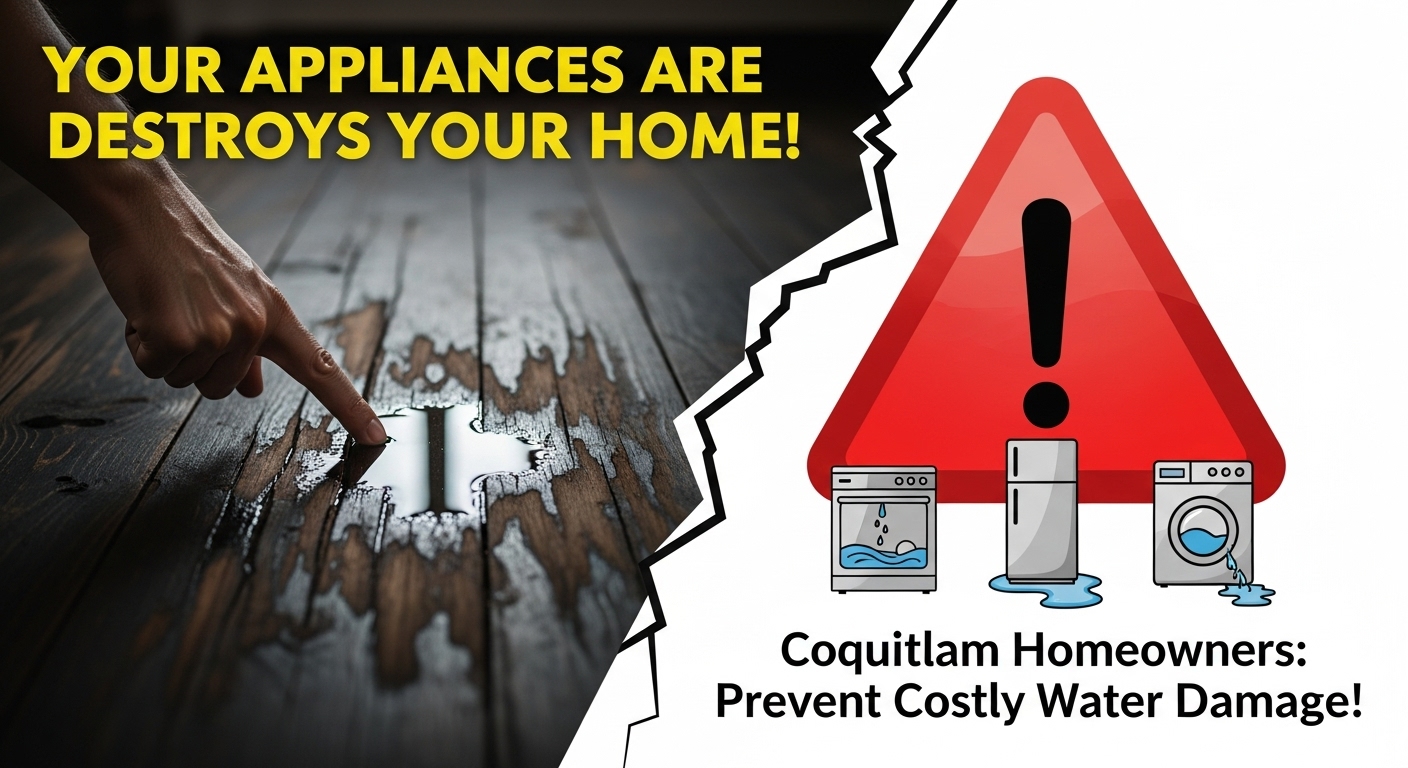
Dealing with water damage from leaking appliances in your Coquitlam home? You’re not alone – thousands of homeowners discover too late that their dishwasher, refrigerator, or washing machine has been silently destroying expensive hardwood floors and cabinets for months.
Picture this: You return from a weekend getaway to find your beautiful oak kitchen floor buckled and warped, with cabinet doors that won’t close properly and a musty smell that hits you the moment you walk through the door. The culprit? A slow dishwasher leak that’s been dripping behind your cabinets for weeks, causing thousands of dollars in damage that could have been prevented with a $20 inspection and some basic maintenance.
In Coquitlam’s humid Lower Mainland climate, appliance leaks don’t just damage surfaces – they create perfect conditions for rapid mold growth and structural damage that can compromise your home’s value and your family’s health. With approximately 14,000 water damage incidents occurring daily across North America and the average repair bill reaching $3,900, understanding how to protect your hardwood floors and cabinets from appliance-related water damage isn’t just smart – it’s essential.
This comprehensive guide will teach you exactly how your everyday appliances are putting your most valuable home features at risk, what warning signs to watch for, and the proven prevention strategies that can save you thousands in repair costs. From the hidden water pathways that turn a small leak into major structural damage to the specific maintenance schedules that protect your investment, you’ll learn everything you need to keep your Coquitlam home safe from appliance water damage.
Key Outtakes
- Washing machine hoses last only 8-9 years and cause some of the most catastrophic flooding when they burst, especially in upstairs laundry rooms
- Water damage to hardwood floors costs $8-$100 per square foot to repair depending on severity, with MDF cabinets often requiring complete replacement rather than restoration
- Installing automatic shutoff valves and leak detection sensors can prevent thousands of dollars in damage for a minimal investment of $300-$500
- Insurance typically covers sudden appliance leaks but excludes gradual damage from poor maintenance, making prevention critical
- Coquitlam’s humid Lower Mainland climate accelerates mold growth within 24-48 hours of water exposure, requiring immediate professional response
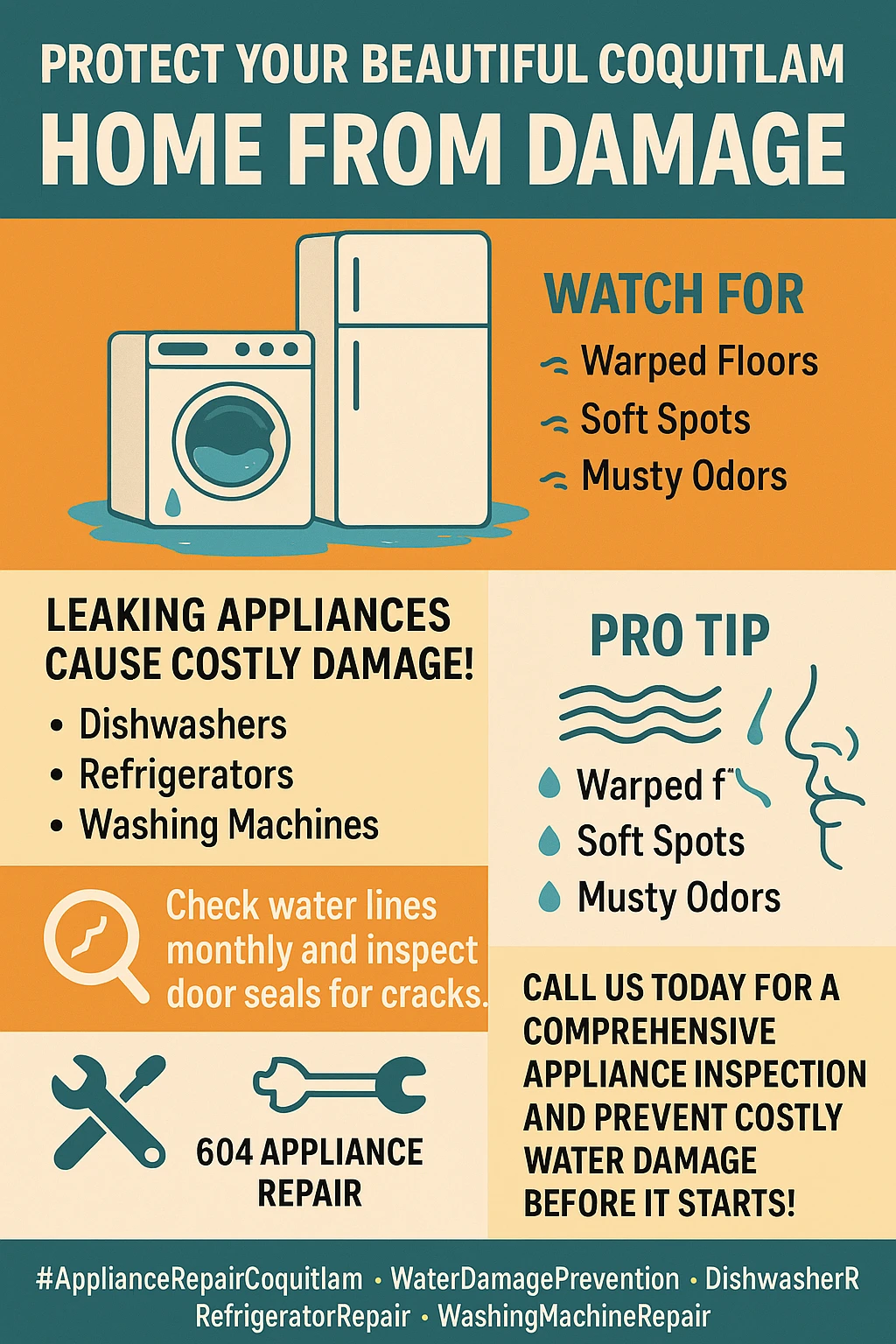
How Appliances Destroy Your Floors and Cabinets
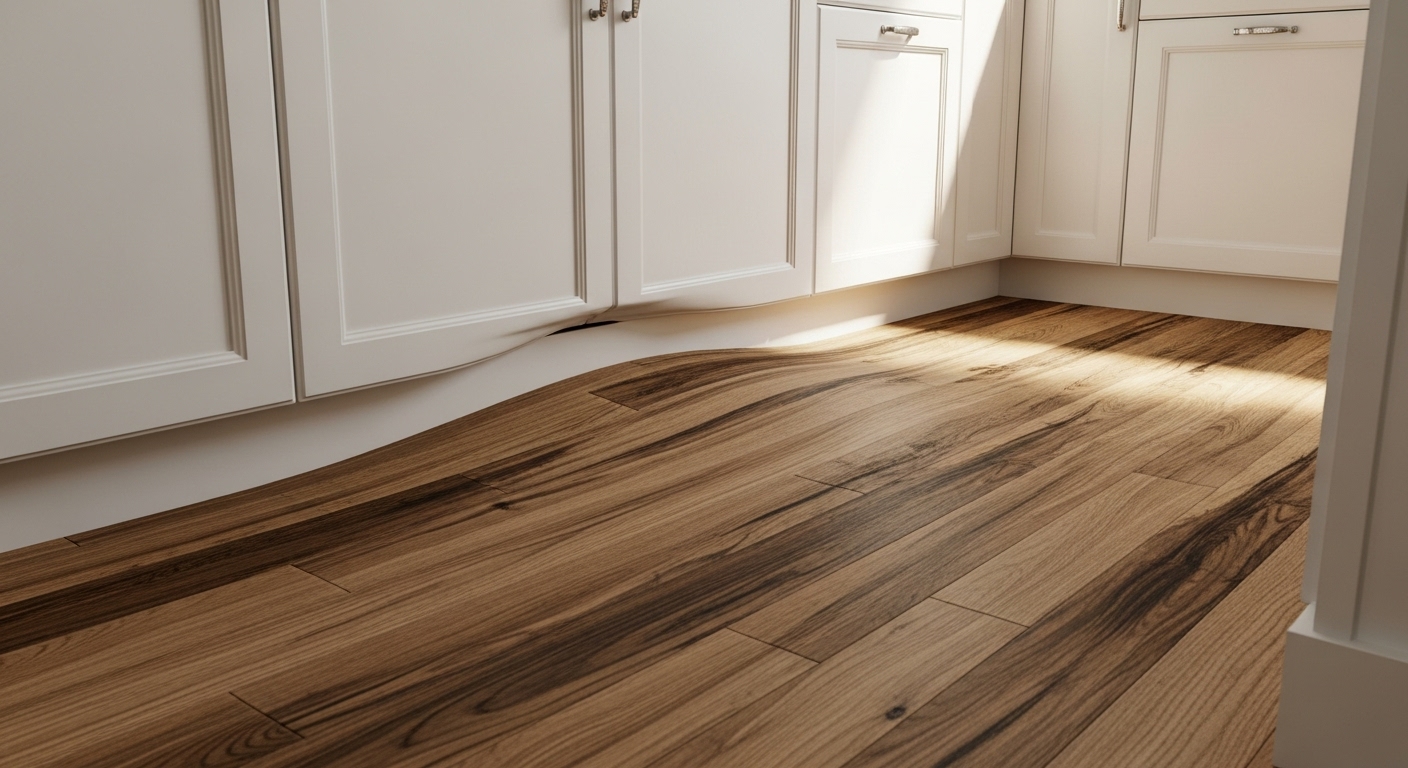
Understanding how water moves through your home is crucial to protecting your investment. When appliances leak, water doesn’t just stay where you can see it – it follows hidden pathways that can cause extensive damage before you even notice a problem. Water always travels to the lowest spot it can, and even after you’ve cleaned up visible pooling, moisture may have already seeped underneath floorboards into your subfloor, behind cabinets, and into wall cavities.
Hardwood floors are particularly vulnerable because while they have protective top coatings, the undersides and edges remain unfinished and absorb moisture rapidly. Over time, this leads to warping, buckling, and staining of wooden floors that can cost $8-$100 per square foot to repair depending on severity. The damage often starts at walls and cabinet bases where water naturally collects, making appliance areas the highest-risk zones in your home.
Modern cabinets face an even greater threat because most are constructed from MDF (Medium Density Fiberboard) rather than solid wood. Unlike real wood which may be salvageable after water exposure, MDF absorbs water rapidly and swells irreversibly, often requiring complete cabinet replacement at costs ranging from $3,000 to $15,000 for an average kitchen. This is why even small appliance leaks can result in major renovation projects if not caught early.
Perhaps most concerning is subfloor damage that occurs when water sits on floors for 24 hours or more and seeps underneath your flooring. Wooden subfloors made from plywood or OSB begin deteriorating rapidly when saturated, and if water reaches the edges of your floors through capillary action, the entire subfloor system may need replacement at costs of $3,000-$7,000. This hidden damage explains why minor appliance leaks often result in major unexpected expenses.
The Three Main Culprits: Dishwashers, Refrigerators, and Washing Machines
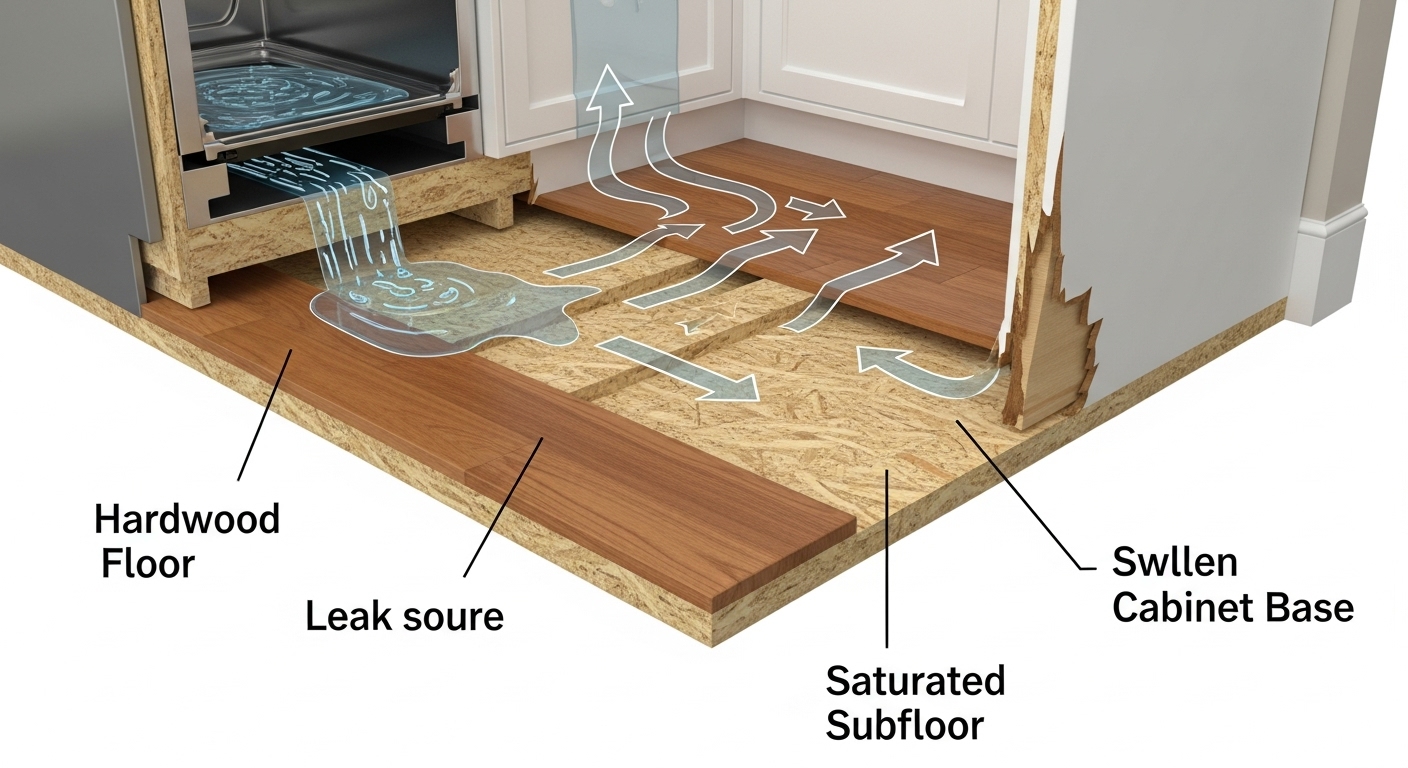
While any water-connected appliance can cause damage, three appliances account for the majority of catastrophic water damage in Coquitlam homes. Each presents unique risks based on their location, water pressure, and typical failure patterns that every homeowner should understand to protect their property effectively.
Dishwasher leaks are often called “the silent floor destroyer” because they typically occur behind cabinets where damage goes unnoticed for months. Common causes include worn-out door gaskets, loose or damaged hoses, faulty water inlet valves, clogged filters, and overloading that causes overflow. The warning signs include soft or spongy flooring near the dishwasher, musty odors after running cycles, cabinet doors that stick or won’t close properly, and small pools of water that appear after wash cycles. Because dishwashers are installed directly against hardwood floors with minimal clearance, even small leaks can cause extensive damage before detection.
Refrigerator water damage typically develops as a slow leak that compounds over time, making it particularly insidious. The most common cause is a clogged defrost drain that allows water to pool inside the refrigerator and eventually overflow onto floors. Other frequent issues include damaged door seals that allow condensation to escape, broken water dispensers, damaged water lines, and ice maker malfunctions. If your fridge has a water dispenser or ice maker, you’re at higher risk because these features require water lines that can fail due to damaged valves, improper sealing, or age-related deterioration. These leaks often occur behind the appliance where they’re invisible until significant damage has occurred.
Washing machine failures represent the most catastrophic appliance water damage scenario, with the average insurance claim reaching $10,000 when hoses burst. According to plumbing experts, washing machine hoses typically last 8-9 years, and Farmer’s Insurance reports that broken water lines cause half of all washing machine damage claims. The risk is amplified in upstairs laundry rooms where a burst hose can flood multiple levels of your home. The key vulnerability is that standard rubber hoses experience constant pressure cycles that eventually cause fatigue and sudden failure, often while homeowners are away or asleep.
Lesser-known appliances also pose risks that many Coquitlam homeowners overlook. Modern dryers with steam capabilities have water connections that can leak, and some high-end models include condensation systems that can malfunction. Water heaters, while not technically kitchen appliances, can cause extensive damage when tanks fail or connections loosen, particularly affecting basement floors and adjacent rooms. Even small appliances like dishwashers in secondary kitchens or wet bars can cause significant localized damage that spreads if not addressed quickly.
Coquitlam Climate and Housing Considerations
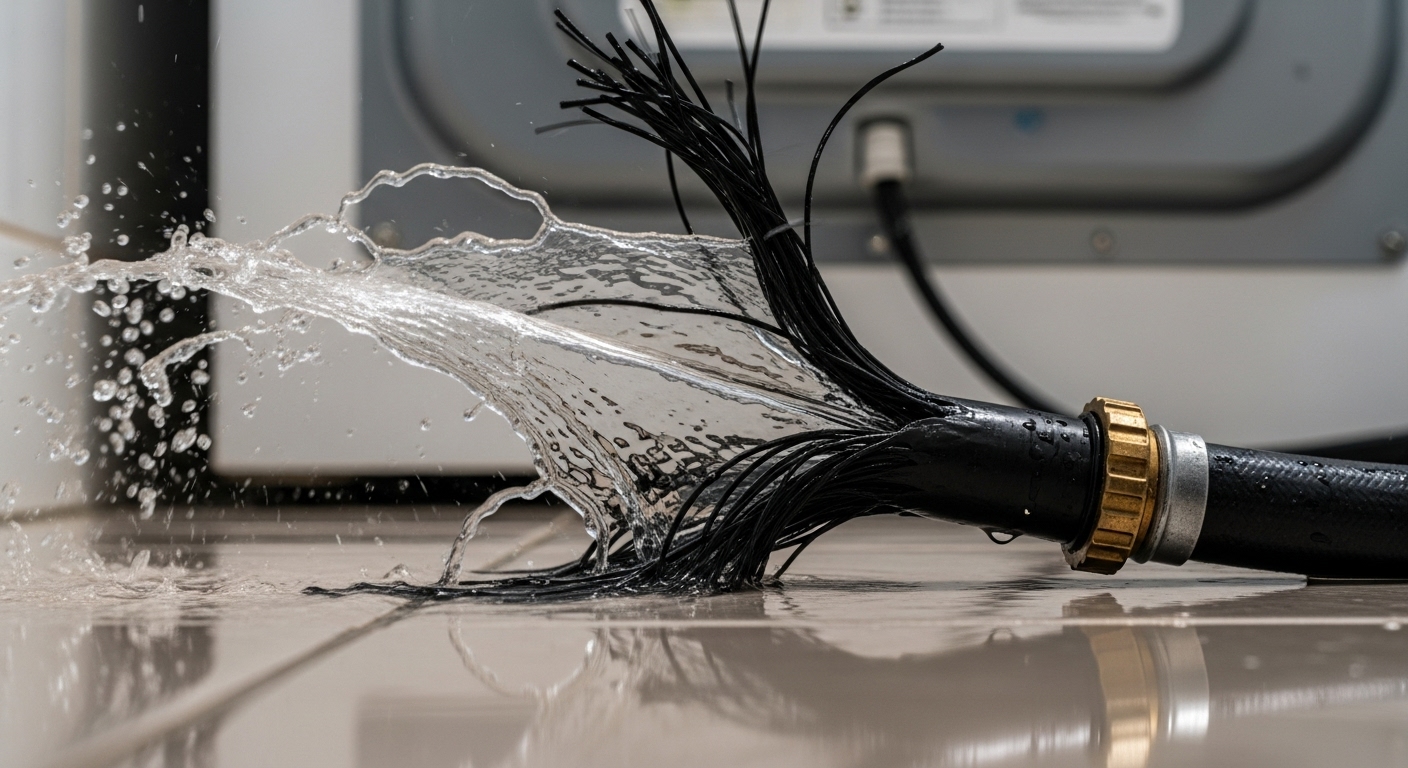
Living in Coquitlam’s Lower Mainland climate creates unique water damage risks that amplify the threat from appliance leaks. The region’s average humidity levels of 70-80% year-round mean that any moisture from appliance failures creates ideal conditions for rapid mold growth and extended drying times that compound damage costs.
The wet season from October through March brings 150-200mm of monthly rainfall, which coincides with increased appliance usage as families spend more time indoors doing laundry and using dishwashers. This seasonal pattern creates a perfect storm where external humidity combines with internal appliance leaks to accelerate damage progression. Mold and bacteria thrive in damp conditions, and research shows that growth can begin within 24-48 hours of moisture exposure – significantly faster in humid environments like Coquitlam’s.
Many homes in the Tri-Cities area were built between 1960-1980 and feature aging plumbing systems that increase appliance leak risks. These older homes often have galvanized steel pipes that are more prone to pressure fluctuations and connection failures, while their original appliance installations may not meet
